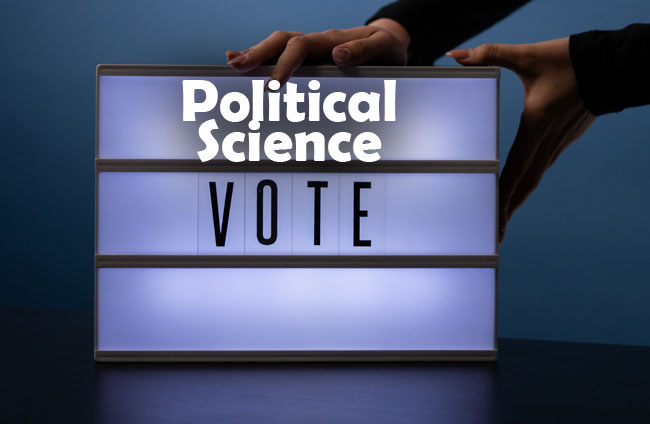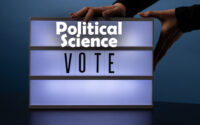Political Science Previous Question
Latest Political Science Previous Question are available here. So, the candidates who are searching can refer the Political Science Previous Question for better preparation. View the free download links of Political Science Previous Question Papers in the below section.

Political Science Objective Previous Question are available here to download for free. Aspirants can download Political Science Previous Question Solved Papers from our website. We have updated the Political Science Previous Question which helps the candidates who are appearing for the competitive exam.
Previous Question on Political Science
1. Which of the following is not a Directive Principle of State Policy?
(A) Equitable redistribution of resources
(B) Uniform Civil Code
(C) Panchayati Raj System
(D) Affirmative Action
2. Preamble of the Indian Constitution is written in the name of ………….. of India.
(A) Judiciary
(B) People of India
(C) Legislature
(D) President
3. Lok Sabha, Rajya Sabha and President are part of …………….. of India.
(A) Parliament
(B) Judiciary
(C) Executive
(D) Panchayati Raj
4. Which of the following patterns of representation is not provided for in the Indian Constitution?
(A) Teachers’ constituency
(B) Graduates constituency
(C) Nominated members
(D) Religious constituency
5. ……………. was the Speaker of 16th Lok Sabha.
(A) Meera Kumar
(B) GMC Balyogi
(C) Sumitra Mahajan
(D) Nirmala Sitaraman
6. Which of the following states was not created in the year 2000?
(A) Chhattisgarh
(B) Mizoram
(C) Jharkhand
(D) Uttarakhand
7. Government of Maharashtra appointed the following committee to study regional imbalance:
(A) Vijay Kelkar Committee
(B) Anil Kakodkar Committee
(C) D. N. Dhanagare Committee
(D) Raghunath Mashelkar Committee
8. Which of the following was the initial ideology of the Bhartiya Janata Party (BJP)?
(A) Radical Humanism
(B) Fabian Socialism
(C) Gandhian Socialism
(D) Hindutva
9. Civil Society Group that launched campaign in Delhi in the year 2011 under the leadership of Anna Hajare in 2011 is ………………. .
(A) Narmada Bachao Andolan
(B) India Against Corruption
(C) Lokpal
(D) Delhi Against Corruption
10. Decentralisation of power to Rural and Urban Local Self Government Institutions is done through the following schedules in the
Constitution:
(A) 10 and 11
(B) 11 and 12
(C) 6 and 8
(D) 9 and 10
11. Which of the following is not a breakaway faction of the erstwhile Janata Dal?
(A) JD (U)
(B) RJD
(C) JD (S)
(D) BJS
12. Political parties were mentioned in the Constitution first by the ………….. Amendment.
(A) 42nd
(B) 52nd
(C) 73rd
(D) 86th
13. UPSC does not recruit candidates by the following method:
(A) Direct Recruitment
(B) Deputation
(C) Transfer
(D) Promotion
14. National Human Rights Commission (NHRC) was established in the year …………. .
(A) 1993
(B) 1998
(C) 2003
(D) 2012
15. The idea of the basic structure of the Constitution was discussed in the:
(A) S. R. Bommai Case
(B) Golak Nath Case
(C) Kesavananda Bharti Case
(D) Sajjan Singh Case
16. Who among the following argued in favour of and emphasized the need to employ the concept of ecology?
(A) John M. Gous
(B) Henri Fayol
(C) Max Weber
(D) Elton Mayo
17. Hawthorne experiments enhanced the importance of:
(A) Formal organisation
(B) Informal organisation
(C) Scientific management of organisation
(D) Work-wage parity
18. Give the correct answer by using the codes given below:
Assertion (A): The systems approach is based on the view that organization should be studied as a whole because the behaviour of one part has a considerable impact on the other parts.
Reason (R): The systems approach ignores the actions between a system and its environment.
Codes:
(A) Both (A) and (R) are true and (R) is the correct explanation of (A)
(B) Both (A) and (R) are true but (R) is not the correct explanation of (A)
(C) (A) is true but (R) is false
(D) (A) is false but (R) is true
19. Who among the following viewed all organizations as systems of cooperation of human activity and proposed the theory of “contributionsatisfaction- equilibrium” as the basis for individual contribution to organization?
(A) F. W. Taylor
(B) Chester I. Bernard
(C) L. Urwick
(D) L. D. White
20. The origin of public choice approach is generally credited to the works of:
(A) Duncan Black
(B) William Riker
(C) Mansur Olsen
(D) Anthony Downs
| Test Papers | Model Question |
| Important Question | Previous Papers |
| Practice Set | Quiz |
| Mock Test | GK |
| Sample Question | MCQ |
21. Which one of the following essays is regarded as founding essays of Public Administration?
(A) Management Throughout History
(B) Ethics and the Public Service
(C) Research in Public Administration
(D) The Study of Administration
22. Who defined administration as domination or exercise of authority while most others defined it as service or performance of duty?
(A) Claus Offe
(B) Karl Marx
(C) Robert Michels
(D) Max Weber
23. The National Institution for Transforming India (NITI) Aayog is:
(A) a statutory body
(B) an executive body
(C) a constitutional body
(D) an advisory body
24. Which one of the following indicators is identified by the United Nations as the governance indicator for sustainable development?
(A) Drinking water
(B) Corruption
(C) Literacy
(D) Mortality
25. Judiciary ensures accountability of administration through:
(a) Curbing arbitrariness of administrative agencies
(b) Safeguarding the rights and liberty of the citizens
(c) Declaring ultra vires the acts of administration if they exceed their jurisdiction
Codes:
(A) (a) and (c)
(B) (a) and (b)
(C) (a), (b) and (c)
(D) (b) and (c)
26. Which one of the following is not a means of popular control over public administration in India?
(A) Election
(B) Public hearings
(C) Public opinion
(D) Financial audit
27. Legislative control over Indian public administration is in form of:
(A) External control
(B) Internal control
(C) Popular control
(D) Direct control
28. National Rural Health Mission (2005) is mandated to strengthen public health systems in the States and Union Territories by:
(a) augmentation of health infrastructure
(b) increasing human resources
(c) mainstreaming of AYUSH
(d) providing mobile medical units
Codes:
(A) (a) and (b)
(B) (c) and (d)
(C) (b) and (d)
(D) (a), (b), (c) and (d)
29. The Right to Free and Compulsory Education Policy of 2009 does not provide for:
(A) Non-justiciable right to all children between the ages of 6-14 years
(B) Free and compulsory education
(C) Education of equitable quality
(D) Maintaining pupil teacher ratio norms and standards
30. Credit linked subsidy for economically weaker section on the housing loans is provided under:
(A) Indira Awas Yojna
(B) Pradhan Mantri Awas Yojna
(C) Rajiv Awas Yojna
(D) Atal Mission
31. Issues and challenges of participatory development paradigm in India are:
(a) Poor development governance
(b) Poor involvement of civil society organisations in the development process
(c) Effective democratic decentralization
Codes:
(A) (a), (b) and (c)
(B) (b) and (c)
(C) (a) and (b)
(D) (a) and (c)
32. E-governance is an instrument of achieving good governance because it:
(a) improves efficiency and economy
(b) enhances citizens government interface
(c) improves decision-making
(d) increases transparency in government operations
Codes:
(A) (a) and (b)
(B) (b) and (c)
(C) (c) and (d)
(D) (a), (b), (c) and (d)
33. Which of the following description does not fit the concept of ‘Multiculturalism’?
(A) Salad Bowl
(B) Cultural Mosaic
(C) Melting Pot
(D) Homogeneous Society
34. Who among the following argued that ‘Man is working species’?
(A) Babeuf
(B) Karl Marx
(C) Hegel
(D) Gramsci
35. Who among the following argued that ‘Power is repressive’?
(A) Gramsci
(B) Karl Marx
(C) Hegel
(D) Foucault
36. What is the source of Marx’s famous statement that “The History of all hitherto existing societies is the history of class struggle”?
(A) The Civil War in France
(B) On the Jewish Question
(C) Manifesto of Communist Party
(D) Contribution to a Critique of Political Economy
37. Which variant of liberalism espouses sympathetic consideration of cultural differences, group rights and majority-minority relations as its core values?
(A) Multiculturalism
(B) Classical liberalism
(C) Communitarianism
(D) Libertarianism
38. Give the correct answer to the statement below:
Post-modernist typically argued that ……..
(A) ‘Universalist’ narratives which attempt to explain the world are invariably false.
(B) The world is socially constructed in a variety of ways.
(C) Differences of viewpoints should be celebrated not deplored
(D) All of the above
39. Which of the following pairs is correct?
(A) Conservatism — Anti-social change
(B) Conservatism — Anti-authority
(C) Conservatism — Anti-organic society
(D) Conservatism — Anti-tradition
40. Give the correct answer by using the codes given below:
Assertion (A): The economic theory of the ‘Philosophical Radicals’ was directed from the start, towards the practical purpose of freeing commerce from the restrictions.
Reason (R): The general outline of utilitarian thinking was announced in Bentham’s earliest work, ‘The Fragment of Government’.
Codes:
(A) Both (A) and (R) are true and (R) is the correct explanation of (A)
(B) Both (A) and (R) are true but (R) is not the correct explanation of (A)
(C) (A) is true but (R) is false
(D) (A) is false but (R) is true
41. Who is the author of the book ‘Prison Notebooks’?
(A) Franz Fanon
(B) Karl Marx
(C) Antonio Gramsci
(D) V.I. Lenin
42. Who among the following wrote the book ‘Wretched of the Earth’?
(A) Karl Marx
(B) Lenin
(C) Franz Fanon
(D) Hannah Arendt
43. The negative theory of liberty was advocated by:
(A) John Stuart Mill
(B) T.H. Green
(C) Isaih Berlin
(D) Karl Popper
44. Which one of the following thinkers stressed the productive dimension of power?
(A) Foucault
(B) Mill
(C) Marx
(D) Lasswell
45. Who among the following used the expression ‘forced to be free’ in connection with the notion of liberty of the individual?
(A) Rousseau
(B) Locke
(C) Green
(D) Hobhouse
46. Who among the following said that democracy can become ‘tyranny of the majority’?
(A) J. Rousseau
(B) De Tocqueville
(C) J.S. Mill
(D) James Madison
47. Who argued that ‘life, liberty and property’ are inalienable rights of men?
(A) Aristotle
(B) Rousseau
(C) Hobbes
(D) Locke
48. The term Legitimation crisis is most associated with:
(A) Gramsci
(B) Foucault
(C) Habermas
(D) Lenin
49. From whom does Marx borrow but fundamentally modify his dialectic method?
(A) Kant
(B) Hegel
(C) Adam Smith
(D) Ludewig Feuerbach
50. Who described freedom as the ‘silence of the laws’?
(A) Isaiah Berlin
(B) Thomas Hobbes
(C) Milton Friedman
(D) J.S. Mill

